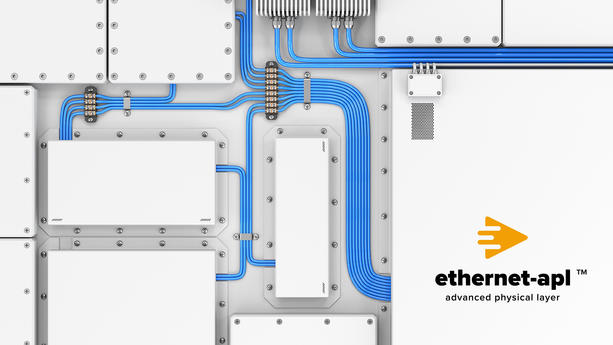
The Ethernet Advanced Physical Layer
The key to successful digitization in the field of process industries
Ethernet-APL—Digitization Reaches the Field of Process Industries
With the Ethernet Advanced Physical Layer, Ethernet-APL for short, Pepperl+Fuchs and other companies set a major milestone to bring digitization into every corner in the field of process plants. Ethernet-APL includes long cable lengths, explosion protection, and interoperability, enabling continuous and transparent communication across all hierarchy levels.
Do you want to learn more? Our Ethernet-APL experts are happy to introduce the future-proof technology, and to discuss the next steps with you. Simply contact us.
Highlights—Why Ethernet-APL?






Ethernet-APL Expert Talk at ACHEMA 2024
Ethernet-APL is a real game changer—this was the conclusion of all those who exchanged views at this year's ACHEMA during the first Ethernet-APL Expert Talk. Pepperl+Fuchs hosted this discussion for the first time. Watch this video to find out which questions and challenges were highlighted by experts, customers and interested parties.
The First Ethernet-APL Field Switch for the Process Industry

The digital transformation is reaching the field level in process plants: The Ethernet-APL rail field switch from FieldConnex® is the first switch in process automation to enable direct, quick, barrier-free access to field devices via Ethernet-APL.
Benefits
Increased Plant Availability
Simple, Cost-Effective Plant Modernization

Flexible Use Worldwide
Shaping the Future of Process Industries: Basics, Terminology, Topologies
The Ethernet Advanced Physical Layer—Ethernet-APL for short—enables the fastest and most efficient communication of large amounts of data from hazardous areas to the cloud. Learn what Ethernet-APL means and which aspects need to be standardized to get a fully comprehensive definition of a physical layer.
Ethernet-APL includes long cable lengths, explosion protection, and interoperability, enabling continuous and transparent communication across all hierarchy levels. The trailer offers a glimpse of this pioneering technology ...
The Ethernet Advanced Physical Layer fits any process plant as the installation architecture provides flexibility and explosion protection for all types of hazardous areas. The video illustrates typical topologies for process automation …
How to Realize Intrinsic Safety with Ethernet-APL
See this video to learn how easy it is to realize intrinsic safety with Ethernet-APL. Ethernet-APL borrows the concept known from FISCO, but allows higher performance and greater distances between switch and field device. For the verification of intrinsic safety, an additional chapter was included in the well-known IEC standard (IEC 60079). This concept for intrinsic safety of Ethernet APL connections is called 2-WISE for Two-Wire Intrinsically Safe Ethernet.
Thus, 2-WISE is not completely new after all. The majority of users who today have to use the entity concept to prove intrinsic safety for device technology with analog signals will be relieved when using Ethernet APL.
Intrinsic Safety without Any Calculations

In order to simplify the test process for validating the intrinsic safety of Ethernet APL devices and cables within APL segments, a new system concept has been standardized in IEC TS 60070-47 (2-WISE). It specifies universal limits for defining intrinsic safety in APL circuits.
The manufacturer of an Ethernet-APL compatible field device guarantees compliance with the required limit values according to 2-WISE. A distinction is made not only between different zones, but also between divisions. The user must select the devices according to the desired zone, ensure a suitable cable and document the installation. Time-consuming own calculations are therefore no longer necessary.
Operate All Generations of Field Devices
The Field Connex® Ethernet-APL field switch offers a dual function for PROFIBUS PA instruments. In addition to Ethernet-APL, it automatically recognizes the Profibus PA fieldbus protocol and maps the data from the instruments to PROFINET for the control technology. This function is defined as "Proxy" in the standards for Profinet and Profibus. The most important element of this technology is that this transfer is handled for all protocols and devices commonly in the engineering station and is very clear for planners and operators.
Seamless device integration into the control station and the engineering system is achieved via the PA profile, which is standardized for Profibus and Profinet. It defines the measured values, configuration parameters and collective messages of the same field devices, even from different manufacturers. It also saves effort during the engineering of a large number of measurements and device replacements.
Great Variety with the SR Series

Designed for use in hazardous areas and harsh environments, the SR series offers different sizes and dimensions for a variety of different Ethernet-APL applications. Any accessories, such as flange plates, hinges, mounting brackets or lid security can be integrated according to customer specifications. The SR enclosures are manufactured from brushed AISI 316L stainless steel and all fixings are manufactured from A4 grade stainless steel as standard to provide excellent tarnish and corrosion resistance.
The Cost-effective Solution: GR Enclosures

The GR enclosure series consists of carbon-loaded, glass-fiber reinforced polyester with stainless steel cover screws. The enclosure series provides an anti-static, UV stabilized and corrosion resistant solution. Many attributes simplify installation and handling such as dedicated pry points for opening, a foamed gasket for IP66, and special protection for the sealing edge. With an expanded operating temperature range down to -60 °C, the GR enclosure series can serve as a cost-effective choice for many installations that would otherwise require stainless steel enclosures.
Contact Us
Do you have any questions about the Ethernet advanced physical layer (Ethernet-APL), or do you want to receive more information? We are happy to help! Simply fill out the contact form and send us a message.


 More Information
More Information

 +61 3 9358 3400
+61 3 9358 3400